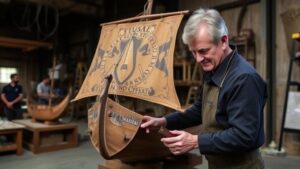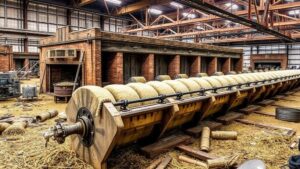Tracing Historical Shipbuilding Blueprints for Forgotten Maritime Tools
Tracing Historical Shipbuilding Blueprints for Forgotten Maritime Tools
The evolution of maritime technology has been pivotal in shaping trade, exploration, and cultural exchanges across the globe. Shipbuilding, as a critical component of this evolution, has been influenced by various socio-economic factors and technological advancements. This article aims to trace the historical blueprints of shipbuilding and the forgotten maritime tools that have been relegated to obscurity. By examining the interplay of historical documentation, archeological findings, and industrial heritage, we highlight the significance of these maritime artifacts.
The Importance of Blueprints in Shipbuilding History
Blueprints serve as essential documentation of shipbuilding practices, akin to architectural plans for buildings. They provide insights into the design, construction techniques, and technological capabilities of various eras. Historical blueprints allow researchers to understand how maritime tools and vessels were adapted for specific functions and environments.
The Age of Exploration: Late 15th Century to Early 17th Century
During the Age of Exploration, significant maritime tools evolved, driven by the need for greater navigational accuracy and cargo capacity. Historical records, such as the shipbuilding documents from the Spanish shipyards of Seville and the British dockyards, provide a foundational understanding of ship design in this period.
- The caravel, a small, highly maneuverable ship, emerged around 1450, known for its ability to sail windward thanks to its lateen sails.
- The galleon, developed in the 16th century, combined cargo capacity with military capability, paving the way for large-scale trade expeditions.
Documentation and Preservation of Maritime Tools
Efforts to document and preserve historical shipbuilding blueprints often waver, affecting the understanding of maritime heritage. Organizations like the National Maritime Museum in Greenwich, England, and the Vasa Museum in Stockholm, Sweden, actively pursue the preservation of shipbuilding artifacts and blueprints.
Archival Research
Archival research is indispensable in tracing forgotten maritime tools. Ship logs, merchant records, and minutes from shipbuilding guilds reveal insights into specific designs, construction methods, and the tools used. For example, records from the early 18th century in the Massachusetts Bay Colony indicate the use of a hand-cranked tool known as the luffing rig, which optimized sail configurations and thus improved maritime efficiency.
Archaeological Discoveries
Archaeology has also played a crucial role in uncovering forgotten shipbuilding practices. Shipwrecks frequently yield artifacts that inform scholars about construction methods and tools that were in use. For example, the remnants of the 18th-century pirate ship, Whydah, discovered off the coast of Cape Cod, revealed unique shipbuilding techniques and tools, including specialized caulking tools used to waterproof the hull.
Case Study: The U.S. Navy’s Historical Resources
The U.S. Navy boasts an extensive archive of blueprints, such as those associated with the USS Constitution, launched in 1797. These documents not only provide insight into naval architecture but also showcase the evolution of shipbuilding techniques over centuries.
Technological Innovations
The historical blueprints illustrate technological innovations such as the introduction of iron hulls and steam propulsion in the 19th century. Each advancement reflects broader industrial trends that influenced maritime engineering.
Real-World Applications
Understanding these historical documents facilitates contemporary shipbuilding practices. Modern shipbuilders study past designs to promote sustainability and resilience in current maritime projects. The principles derived from historical blueprints guide the development of eco-friendly vessels and advanced navigation systems.
The Impact of Digital Archives
Digital technologies are revolutionizing the preservation and accessibility of maritime blueprints. Institutions such as the British Library and the Library of Congress have initiated digitization projects that make historical documents accessible worldwide. These digital archives provide invaluable resources for historians, shipbuilders, and enthusiasts.
Conclusion
Tracing historical shipbuilding blueprints highlights the intricate relationship between maritime technology and cultural development. Forgotten maritime tools serve as a window into past innovations that shaped global trade and exploration. As we continue to explore and digitize these records, we pave the way for future innovations that honor the past while addressing contemporary maritime challenges.
Actionable Takeaways
- Encourage local museums to document and digitize maritime artifacts for future study.
- Promote collaboration between historians and shipbuilders to integrate historical knowledge into modern practices.
- Support educational programs that emphasize the significance of maritime heritage in contemporary contexts.



